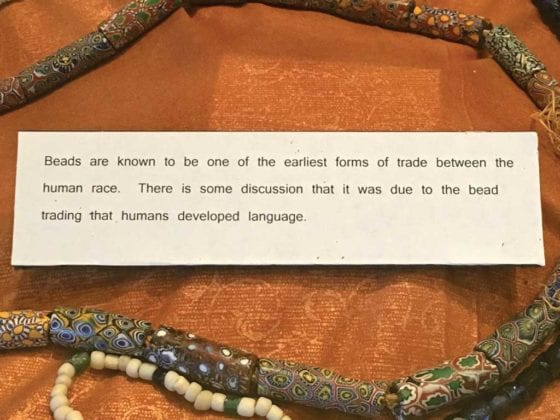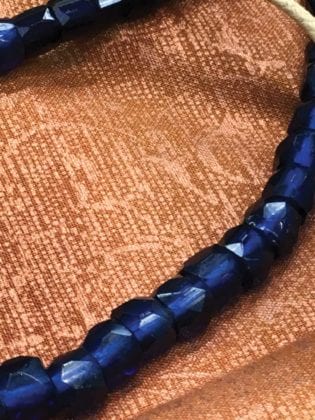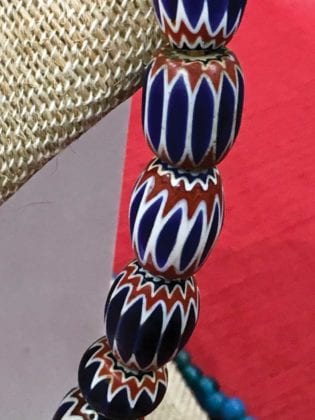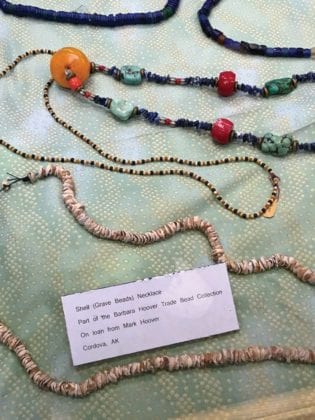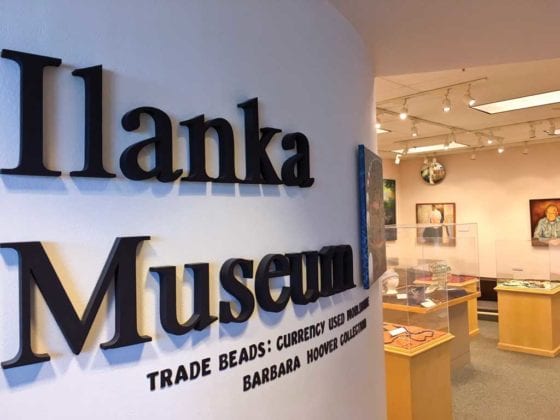Some of us have a certain fascination with beads – the bright, transparent colors of glass that catches the sun, to the textures and shapes to be found in larger beads, such as Chevron beads.
An exhibition, Trade Beads: The Currency Used Worldwide, is under way at the Ilanka Cultural Center Museum through Nov. 15. The beaded necklaces are of varying shapes and sizes are part of artist Barbara Hoover’s extensive collection.
Barbara Hoover, born October 13, 1926, died in Cordova in September 2014. Her collection is on loan to the Ilanka museum from her son, Mark Hoover.
Beads have been prized through the centuries, used for payment and in trading, for embellishing footwear and clothing, and to adorn the body, showing off one’s status in the community, or level of wealth.
Brooke Johnson, director of the Ilanka Cultural Center Museum, saw the collection of trade beads last fall during the Native Village of Eyak’s annual Sobriety Celebration. She knew at that time that she wanted to present the beads in an exhibition at the museum.
“Mark brought the trade beads out during a class we held at the cultural center on thigh spinning,” Johnson said. “We had Mike and Edna Jackson here from Kake, Alaska. They were here teaching the class. They are knowledgeable about trade beads.”
Johnson said that Mark Hoover wanted the Jacksons to see his mother’s trade bead collection.
“He brought them in a box,” Johnson said. “I just remember seeing necklace after necklace being pulled from the box – like it was Mary Poppins’s magic carpet bag.”
Johnson fell in love with the beads. She knew that Barbara’s collection should be shared with others who could see them and who would appreciate them.
“I think they’re an amazing collection,” she said. “Even if not all of the trade beads are from Alaska.”
The word, bead, is derived from the old English word bedu, which means prayer.
There are several types of trade beads on display in the exhibition, from Chevron beads to seed beads, to beads made from Dentalium shells and others.
“Chevron beads were considered a very high-end bead; they were also called rosary beads,” she said. “The beads are multi-layered to produce a star pattern on the ends, which results in stripes on the outside. The original Chevron beads had seven layers and was very difficult to make.”
One of the necklaces on display is made from Dentalium shells, which are a kind of seashell from Scaphopoda mollusks.
Dentalium shells were used by Inuit, First Nations and Native Americans as an international trade item. The use of Dentalium shells is found along the western coast of the United States and Canada. Traditionally, Johnson said, the shells of Dentalium were harvested from Antalis pretiosum, a species that occurred from Alaska to Baja California from deep waters.
Padre beads make up another gorgeous necklace on display as part of Barbara Hoover’s collection.
“Padre beads are wound, opaque, light blue glass beads from China,” Johnson said. “In 1778, Capt. James Cook made several references that it was difficult to obtain supplies and furs from the Pacific Coast Indians without this particular blue bead.”
Another piece in Hoover’s collection is a necklace made from Vaseline or Cave Agate trade beads. These are pressed beads, which are faceted and transparent.
“On the earliest Vaseline beads,” Johnson said, “The hole through the bead is larger on one end, as the hole was made with a hot pointed rod. Vaseline beads were widely traded until the mid-1800s. After the mid-1800s, the Native women requested small seed beads.”
This is a culturally valuable exhibition full of history.
“Please stop by and see this amazing collection,” Johnson said, “That Barbara Hoover accrued throughout the years.”
The Ilanka Cultural Center Museum is open 10 a.m. to 5 p.m. Monday through Friday.
Visit the Ilanka Cultural Center Museum in person at 110 Nicholoff Way in Cordova, or at their facebook page:
https://www.facebook.com/IlankaCulturalCenter/
